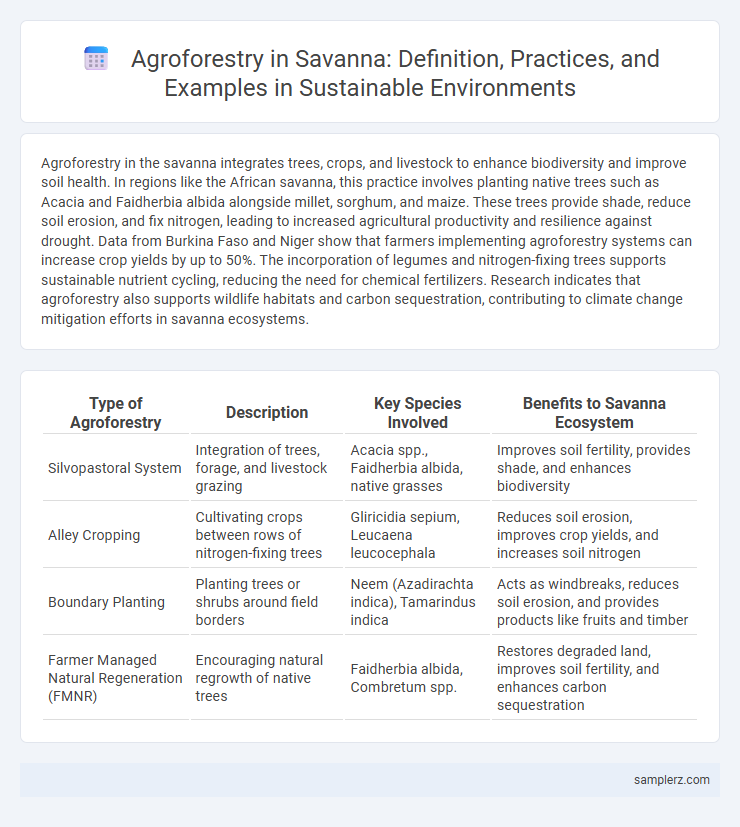Agroforestry in the savanna integrates trees, crops, and livestock to enhance biodiversity and improve soil health. In regions like the African savanna, this practice involves planting native trees such as Acacia and Faidherbia albida alongside millet, sorghum, and maize. These trees provide shade, reduce soil erosion, and fix nitrogen, leading to increased agricultural productivity and resilience against drought. Data from Burkina Faso and Niger show that farmers implementing agroforestry systems can increase crop yields by up to 50%. The incorporation of legumes and nitrogen-fixing trees supports sustainable nutrient cycling, reducing the need for chemical fertilizers. Research indicates that agroforestry also supports wildlife habitats and carbon sequestration, contributing to climate change mitigation efforts in savanna ecosystems.
Table of Comparison
| Type of Agroforestry | Description | Key Species Involved | Benefits to Savanna Ecosystem |
|---|---|---|---|
| Silvopastoral System | Integration of trees, forage, and livestock grazing | Acacia spp., Faidherbia albida, native grasses | Improves soil fertility, provides shade, and enhances biodiversity |
| Alley Cropping | Cultivating crops between rows of nitrogen-fixing trees | Gliricidia sepium, Leucaena leucocephala | Reduces soil erosion, improves crop yields, and increases soil nitrogen |
| Boundary Planting | Planting trees or shrubs around field borders | Neem (Azadirachta indica), Tamarindus indica | Acts as windbreaks, reduces soil erosion, and provides products like fruits and timber |
| Farmer Managed Natural Regeneration (FMNR) | Encouraging natural regrowth of native trees | Faidherbia albida, Combretum spp. | Restores degraded land, improves soil fertility, and enhances carbon sequestration |
Integrating Trees and Crops: Agroforestry Techniques in Savanna Regions
Integrating trees and crops in savanna regions enhances biodiversity, improves soil fertility, and increases crop yields through agroforestry techniques such as alley cropping and silvopastoral systems. Species like Faidherbia albida provide nitrogen fixation and shade, creating a microclimate that benefits staple crops like millet and sorghum. These practices contribute to sustainable land management by reducing soil erosion and promoting carbon sequestration in semi-arid savanna ecosystems.
Silvopasture Systems: Cattle Grazing and Tree Management
Silvopasture systems in savannas integrate cattle grazing with strategic tree management to enhance biodiversity and soil health while optimizing land use. Mature trees such as Acacia and Baobab provide shade, reduce heat stress in livestock, and improve forage quality through nutrient cycling. This sustainable agroforestry practice increases carbon sequestration, mitigates erosion, and supports resilient pastoral livelihoods in savanna ecosystems.
Fruit Orchards in Savanna Landscapes
Fruit orchards in savanna landscapes serve as a key example of agroforestry that enhances biodiversity while providing economic benefits. Integrating fruit trees such as mango, guava, and tamarind with native grasses and crops improves soil fertility, conserves water, and supports local wildlife habitats. This sustainable practice contributes to carbon sequestration and resilience against climate variability in semi-arid regions.
Windbreaks and Shelterbelts: Enhancing Microclimates
Windbreaks and shelterbelts in savanna agroforestry play a crucial role in enhancing microclimates by reducing wind speed and minimizing soil erosion. These tree barriers improve moisture retention, protect crops from harsh winds, and increase biodiversity by providing habitats for various species. Implementing species such as Acacia and Faidherbia albida maximizes ecological benefits and supports sustainable agricultural productivity in savanna regions.
Alley Cropping: Combining Food Crops and Trees
Alley cropping in savanna ecosystems integrates rows of leguminous trees such as Acacia or Faidherbia albida with staple food crops like maize or millet, enhancing soil fertility through nitrogen fixation. This agroforestry practice improves water retention, reduces erosion, and increases crop yields by creating microclimates that protect against harsh savanna conditions. Research in African savannas demonstrates alley cropping's potential to sustainably boost food security while preserving biodiversity and ecosystem services.
Indigenous Agroforestry Practices in Savanna Ecosystems
Indigenous agroforestry practices in savanna ecosystems involve integrating native tree species like shea (Vitellaria paradoxa) and baobab (Adansonia digitata) with traditional crops such as millet and sorghum. These practices promote biodiversity, enhance soil fertility through nitrogen-fixing trees, and improve water retention in arid landscapes. The indigenous knowledge system supports sustainable land management by balancing agricultural productivity with ecosystem conservation in savanna regions.
Baobab Cultivation: Sustainable Land Use Models
Baobab cultivation in savanna regions exemplifies sustainable agroforestry by integrating drought-resistant trees that enhance soil fertility and provide essential nutrients. The deep root systems of baobabs improve water infiltration and reduce erosion, promoting land restoration in semi-arid environments. This agroforestry model supports biodiversity while supplying nutritious fruit, leaves, and seeds that benefit local communities economically and nutritionally.
Soil Restoration through Savannah Agroforestry
Savanna agroforestry integrates native trees such as Acacia and Faidherbia albida with crops to enhance soil fertility and structure through nitrogen fixation and organic matter addition. This practice mitigates soil erosion by improving ground cover and water retention in semi-arid environments. Research in the African savanna demonstrates that agroforestry systems increase soil carbon stocks and nutrient cycling, promoting sustainable land use and restoring degraded savanna soils.
Native Tree Species in Savanna-Based Agroforestry
Native tree species such as Acacia senegal, Vitellaria paradoxa, and Parkia biglobosa play a crucial role in savanna-based agroforestry systems by enhancing soil fertility, providing shade, and producing valuable non-timber products. These species improve water retention and support biodiversity, making them integral to sustainable land management in savanna ecosystems. Integrating native trees with crops and livestock boosts overall productivity and resilience to climate variability.
Climate Resilience: Agroforestry Adaptations in Savanna Regions
Agroforestry systems in savanna regions enhance climate resilience by integrating drought-tolerant tree species like Acacia and Faidherbia albida with staple crops such as millet and sorghum. These tree-crop combinations improve soil fertility through nitrogen fixation, reduce soil erosion, and provide shade that lowers ground temperatures, mitigating heat stress on crops. Such adaptations support sustainable agricultural productivity amid increasing climate variability and prolonged dry seasons in savanna ecosystems.

example of agroforestry in savanna Infographic
 samplerz.com
samplerz.com